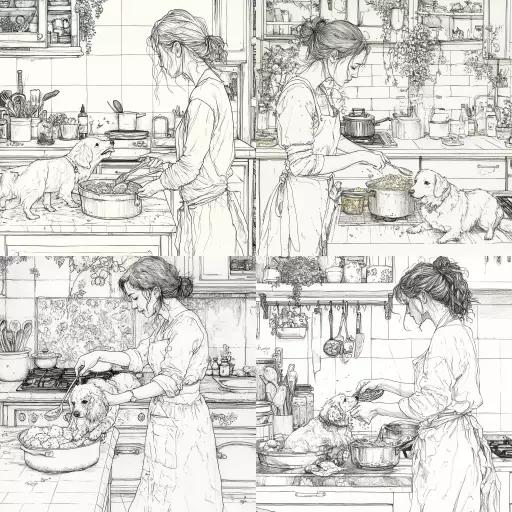Explore the Best AI Image Gallery

Pixels on Skin: How AI Image Generation is Transforming Design
The realm of design has always been a playground for innovation, constantly pushing the boundaries of whats possible. Now, with the advent of Artificial Intelligence (AI) and its ability to generate stunning visuals, the creative landscape is undergoing a seismic shift. This technology, often referred to as AI image generation, is poised to revolutionize how we design, interact with visuals, and even perceive art itself.
A Canvas of Infinite Possibilities
AI image generators, powered by complex algorithms and vast datasets of images, can produce breathtakingly realistic or fantastical artwork at the users command. Designers can input text prompts, concepts, or even sketches, and the AI will translate these into unique visual representations. This opens up a world of possibilities for:
- Concept Visualization: Quickly iterate through design ideas, exploring different aesthetics and compositions without the time constraints of traditional sketching.
- Personalized Design: Create customized visuals tailored to individual preferences, from logos and branding elements to unique patterns and textures.
- Content Creation: Generate images for websites, marketing materials, social media, or even novels, freeing up designers time for more strategic tasks.
The Designers New Toolkit
AI image generation isnt about replacing human designers; its about empowering them with new tools and expanding their creative horizons. Designers can now:
- Focus on the Big Picture: Delegate repetitive tasks like generating initial sketches or variations to the AI, allowing designers to concentrate on higher-level concepts and refining the final product.
- Experiment Fearlessly: Explore unconventional ideas and push creative boundaries without the limitations of traditional tools. The AI can help bring even the most abstract concepts to life.
- Collaborate with AI: View AI-generated images as a starting point for collaboration, building upon the AIs output and adding their own artistic touch.
Navigating the Ethical Landscape
As with any powerful technology, AI image generation raises important ethical considerations:
- Copyright and Ownership: Who owns the rights to AI-generated images? Is it the user who provided the prompt, the developer of the AI algorithm, or the AI itself?
- Bias and Representation: AI models are trained on existing datasets, which can perpetuate societal biases. Its crucial to ensure that AI-generated imagery is inclusive and representative of diverse cultures and perspectives.
- Misinformation and Manipulation: The ability to create realistic images raises concerns about the potential for misuse, such as generating deepfakes or spreading misinformation.
Shaping the Future of Design
AI image generation is still in its early stages, but its impact on the design industry is undeniable. As the technology continues to evolve, we can expect:
- Increased Accessibility: AI tools will become more user-friendly and affordable, empowering individuals and small businesses to participate in the creative process.
- New Artistic Expressions: AI will inspire new forms of art and design, blurring the lines between human and machine creativity.
- Ethical Frameworks: As AIs role in design expands, its essential to develop robust ethical guidelines and regulations to ensure responsible use and mitigate potential harms.
The future of design is a collaborative one, where human ingenuity and AI capabilities intertwine. By embracing this transformative technology responsibly, we can unlock a world of unprecedented creative possibilities and shape a more visually captivating future.



![**Representation: A dog acting as a private tutor to a child. The dog holds a ruler in its paw and stands at the blackboard to explain a dog diagram to the child. Graphic style: Line drawing, cartoon style, influenced by Franco-Belgian comics, thick black lines, simplified design, vector, black and white only, in the style of Keith Haring or the French comic strip "Alinéa". [IMPORTANT]: A single continuous line extending from one side of the image to the other, minimalist, strong outlines, line drawing, without lifting the hand, ultra-simplified, no shading, entirely white image, drawing created in the center of a sheet of paper. --ar 16:5** - <@627984126871470085> (fast)](https://images.ai-img.art/thumbnails/150/7a854648a81e51241dcca8d24dd6e3bfcf07ad1df51baf401c9b729f4cf411fa.webp)


](https://images.ai-img.art/thumbnails/150/157712d76865d557120f9baf988de3d0525225295a2789c89bf2c4a5a96a03d1.webp)










![**Representation: A dog acting as a private tutor to a child. The dog holds a ruler in its paw and stands at the blackboard to explain a dog diagram to the child. Graphic style: Line drawing, cartoon style, influenced by Franco-Belgian comics, thick black lines, simplified design, vector, black and white only, in the style of Keith Haring or the French comic strip "Alinéa". [IMPORTANT]: A single continuous line extending from one side of the image to the other, minimalist, strong outlines, line drawing, without lifting the hand, ultra-simplified, no shading, entirely white image, drawing created in the center of a sheet of paper. --ar 16:5** - Variations (Strong) by <@627984126871470085> (fast)](https://images.ai-img.art/thumbnails/150/f4e034998ccd869d8a061fd12017514fcd92210eb33d4222dc9b54716223f4dd.webp)

![**Representation: A teenager smiling while thinking about a friendly dog, a comic-style thought bubble with a friendly dog inside. Graphic style: Line drawing, cartoon style, influenced by Franco-Belgian comics, thick black lines, simplified design, vector, black and white only, in the style of Keith Haring or the French comic strip "Alinéa". [IMPORTANT]: A single continuous line extending from one side of the image to the other, minimalist, strong outlines, line drawing, without lifting the hand, ultra-simplified, no shading, entirely white image, drawing created in the center of a sheet of paper. --ar 16:5** - <@627984126871470085> (fast)](https://images.ai-img.art/thumbnails/150/6fc850f638e3dee0c4b121acecad2c8419e02bdeac7f871d625f1003c1c3abe1.webp)




](https://images.ai-img.art/thumbnails/150/51c93500396faff4e7fa8b42bc68033067b16b2230e3496e95c482a581ff0fe9.webp)















](https://images.ai-img.art/thumbnails/150/9d51c5e673b4f2068b7b01abc35425a06f173b76303adf9ad29ca14302c25b18.webp)



